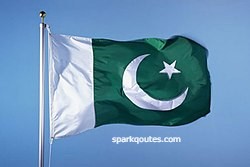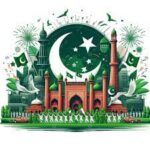Introduction: More Than Just a Flag
Every nation has a soul, and in Pakistan’s case, that soul is stitched into a piece of cloth. 🇵🇰 The national flag of Pakistan, with its vibrant green and pure white colors, is not just a symbol — it’s a silent proclamation of history, identity, and hope.
Waving with pride since August 11, 1947, the flag represents more than the formation of a new country; it’s a reminder of the sacrifices, dreams, and ideals that led to Pakistan’s creation. The green embodies the Islamic majority, while the white stands for religious minorities, symbolizing peaceful coexistence. The crescent stands for progress, and the five-pointed star represents enlightenment.
In this article, we will explore the deep symbolism, rich history, and everlasting relevance of the Pakistani flag — a piece of cloth that speaks volumes without uttering a word.

🏛️ Historical Origins: A Flag Born from a Dream
Pakistan’s flag traces its origins to the All-India Muslim League — the political party that led the struggle for an independent Muslim homeland in South Asia. The design was inspired by the Muslim League flag, which also had a green field and a white crescent and star.
When Pakistan was created in 1947, a new version of the flag was adopted. The visionary Ameer-ud-Din Kidwai, a close associate of Quaid-e-Azam Muhammad Ali Jinnah, was tasked with designing it. His idea was simple but powerful: include both majority and minority communities to emphasize inclusivity and unity. 🤝
Thus, the iconic white stripe was added on the left to represent non-Muslim citizens — a bold and progressive gesture for a new nation. 🕊️
🎨 Symbolism in Colors and Design
The Pakistani flag is a masterpiece of symbolism. Every element has been deliberately chosen to reflect the founding vision of the country.
Green Field (🟩): Represents Islam, the religion of the majority population. It also stands for growth, fertility, and prosperity.
White Stripe (⬜): Symbolizes peace and the protection of religious minorities. It shows Pakistan’s commitment to pluralism.
Crescent Moon (🌙): A traditional Islamic symbol, representing progress and new beginnings.
Five-Pointed Star (⭐): Stands for light, knowledge, and guidance — a nation guided by the principles of justice and truth.
Together, these elements form a unified vision of a progressive, inclusive, and spiritually guided state. 🌍
💬 Quaid-e-Azam’s Vision and the Flag
Muhammad Ali Jinnah, the founder of Pakistan, strongly believed in the rights of minorities. In his historic speech on August 11, 1947, he said:
“You are free; you are free to go to your temples… to your mosques or any other places of worship… You may belong to any religion, caste or creed—that has nothing to do with the business of the State.” 🗣️
The white in the flag is a direct reflection of this ideology. It assures that every citizen, regardless of faith, is part of the national fabric. The flag, in this way, becomes a living embodiment of Jinnah’s vision of religious freedom and national unity. 🇵🇰❤️

🕊️ The White Stripe: A Silent Guardian
In times of national debate and unrest, the white stripe becomes a powerful reminder of what Pakistan stands for. It’s easy to overlook that small section on the left, but it holds moral weight.
This stripe stands up silently for:
Hindus, Christians, Sikhs, Parsis, and other minority groups.
Their right to education, freedom of worship, and protection from discrimination.
The idea that diversity is strength, not division.
In a society striving toward modern democracy, the white stripe says what words often fail to — we are one nation, not fragments. 🏳️🌈🇵🇰
🏞️ The Flag in Everyday Life
From schools to stadiums, from rooftops to military parades — the flag is everywhere in Pakistan. It’s especially visible on Independence Day (14 August) when the streets are draped in green and white, and children wave it with joy. 🎉
The flag becomes:
A symbol of hope during times of crisis.
A reminder of unity during political differences.
A source of pride for Pakistanis living abroad.
Emojis like 💚🇵🇰🕊️ often flood social media, showing how this flag resonates even with the younger generation in the digital age.
📜 Flag Code and Respect
To maintain the dignity of the national flag, the Government of Pakistan has a set of rules known as the Flag Code. Some important guidelines include:
The flag should never touch the ground.
It must be hoisted higher than any other flag.
It is to be flown on government buildings, schools, and at national events.
During mourning, it may be flown at half-mast.
Respect for the flag is not just ceremonial — it’s a moral obligation for every citizen. Disrespecting the flag is equivalent to undermining the values of the nation. 🚫🏴
🌍 The Flag in the Global Context
For Pakistanis abroad, the national flag is often a symbol of identity and connection to home. Whether at international conferences, sports events, or cultural festivals, the green and white flag waves with a pride that crosses borders. 🌐
It tells the world:
We are a people with a rich history.
We believe in peace, progress, and plurality.
We are a sovereign and proud nation.
Many Pakistani embassies and diaspora groups conduct flag-hoisting ceremonies on national holidays, followed by prayers, speeches, and patriotic songs. 🎶🇵🇰
🧒 The Flag and the Youth
For the younger generation, the flag is not just about history — it’s about identity and future. Through schools, social media, and campaigns, children and teens are taught the meaning of the flag.
Many students wear green and white dresses on 14th August, and participate in:
Poster-making competitions 🎨
Speeches and debates 🎤
Flag-hoisting events 📢
National songs and poetry performances 🎵
These traditions build a sense of ownership and pride, ensuring that the message of the flag lives on in the next generation. 🧑🎓🇵🇰

📈 Challenges and Recommitment
While the flag represents noble ideals, reality sometimes falls short. Religious minorities in Pakistan have, at times, faced discrimination and injustice. But this only amplifies the importance of the flag’s silent message.
Each time we look at that white stripe, we are reminded:
That our work isn’t done.
That Jinnah’s dream must be protected.
That unity in diversity is not a cliché — it’s a responsibility.
By honoring the full flag — not just the green, but the white too — we take a step toward national maturity. 👥🤝
🌟 Conclusion: A Pledge in Green and White
The flag of Pakistan is more than just cloth fluttering in the breeze. It’s a silent speech, a visual anthem, and a spiritual contract. With green for Islam and white for peace, it asks every citizen a question:
“Will you stand for what I stand for?” 🇵🇰💚
When we salute the flag, we aren’t just expressing patriotism — we are renewing a pledge to uphold justice, unity, and peace.
So let the crescent shine with progress. Let the star guide us with wisdom. Let the green and white fly high — not just in the skies, but in our hearts, actions, and values. 🌙⭐💚














